Use ChatGPT strategically by starting with clear prompts, adding plenty of context, and including supporting materials like slides or transcripts. The more information you provide, the better the content will match your brand’s voice. Always refine drafts with your own perspective and optimize for both Google SEO and AEO so your content shows up in AI-powered results. Most importantly, remember you’re writing for humans, make it authentic, valuable, and easy to connect with.
By harnessing the power of AI, we can not only streamline content generation but also enhance search engine optimization strategies and efficiently craft engaging blog content.
Related Blog: From SEO to AEO (Answer Engine Optimization): How AI is Redefining Client Acquisition
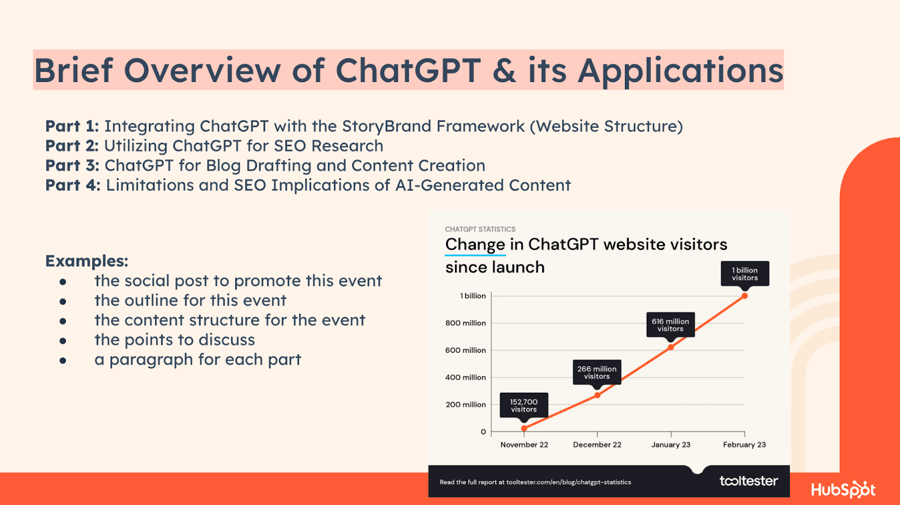
It's crucial to differentiate between AI-generated content and AI-assisted content creation. While the former refers to text created solely by AI, often leading to repetitive or spam-like content, the latter involves collaboration between humans and AI. This collaborative approach, where humans refine and polish the AI-generated foundation, ensures content uniqueness and quality while maintaining the human touch. By leveraging AI and embracing AI-assisted content creation, we can develop more engaging and valuable content that resonates with our audience.
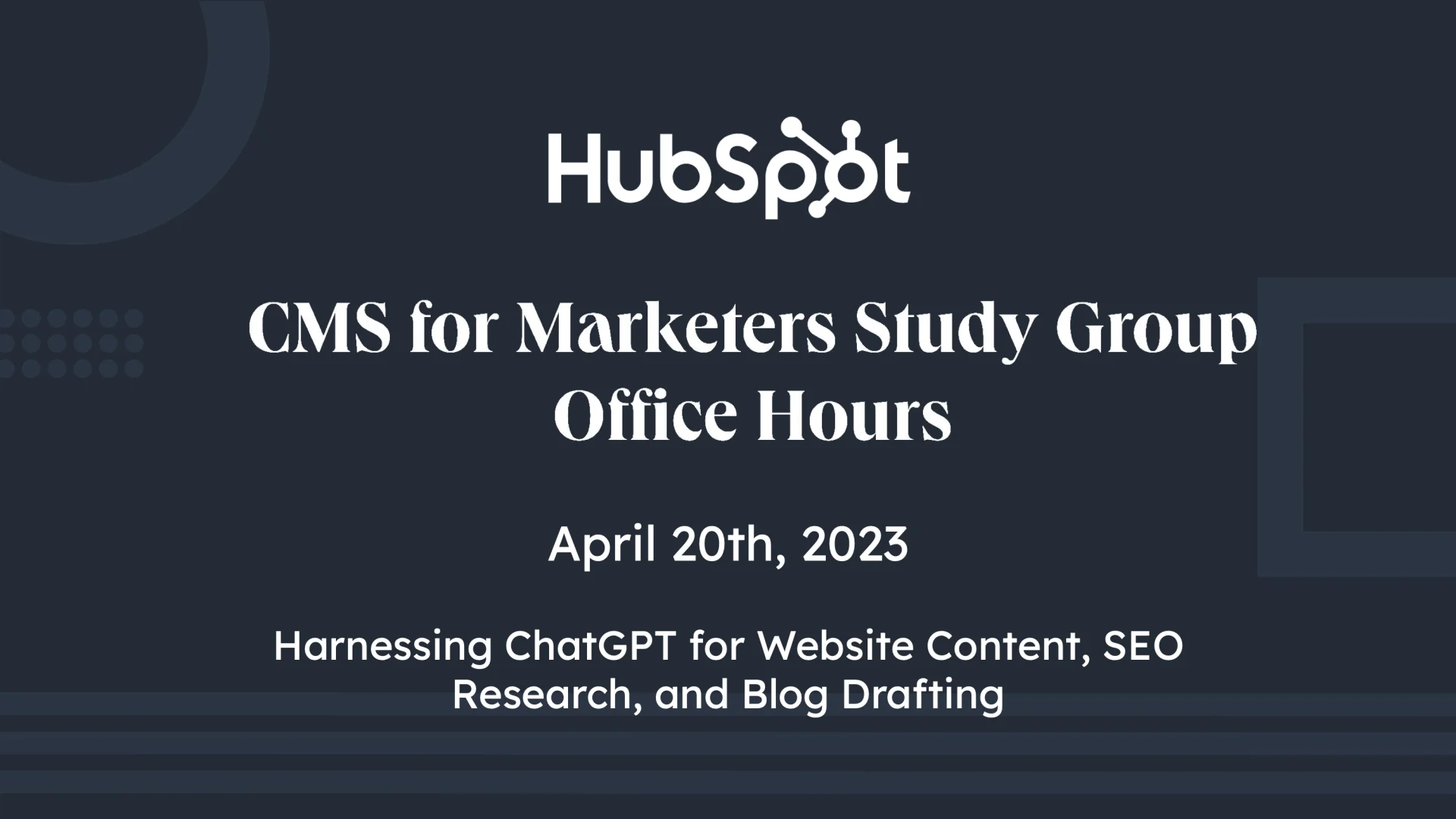
Integrating ChatGPT with the StoryBrand Framework for Website Structure
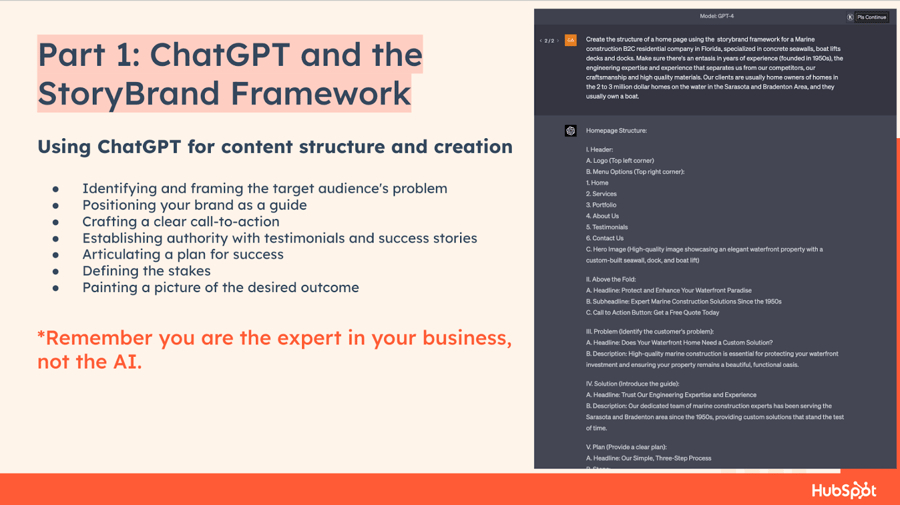
Remember you are the expert in your business, NOT the AI.
ChatGPT has immense potential for generating website content, offering users the ability to draft engaging and informative pieces with ease. This AI tool can assist in various aspects of content creation, from brainstorming ideas to writing entire articles. However, to truly harness the power of ChatGPT, it's crucial to understand the best practices for creating effective content and the importance of human involvement in the process.
Tips for creating effective content with ChatGPT:
- Start with clear and concise prompts: When using ChatGPT, provide a well-defined prompt that clearly communicates your intent. This will help the AI understand your requirements and generate more relevant and focused content.
- Edit and refine the output: Although ChatGPT can generate text quickly, it's essential to thoroughly review and edit the output to ensure accuracy, coherence, and relevance. Don't hesitate to make changes or rewrite sections to improve the overall quality.
- Keep the target audience in mind: Always tailor the content generated by ChatGPT to suit your target audience. This may involve adjusting the tone, style, or language to better resonate with your readers.
The importance of human involvement in the content creation process:
While ChatGPT is an impressive tool, it's essential to recognize that human input is necessary to create truly engaging and unique content. AI-generated content can sometimes lack the nuance, context, and emotional depth that only a human touch can provide. By combining the efficiency and speed of ChatGPT with human creativity and critical thinking, we can create AI-assisted content that strikes the perfect balance between AI-generated and human-crafted material.
Creating content for your website using the StoryBrand Framework and ChatGPT:
Incorporating StoryBrand principles into the AI-assisted content creation process can further enhance the effectiveness of your website content. StoryBrand is a marketing framework that focuses on crafting a clear and compelling narrative, positioning your customer as the hero and your brand as the guide that helps them overcome challenges and achieve their goals.
When using ChatGPT for website content creation, consider incorporating the following StoryBrand principles:
- Define your customer's problem: Clearly articulate the challenges or pain points your target audience faces. ChatGPT can help you create content that addresses these issues and demonstrates empathy, showing that you understand your audience's struggles.
- Position your brand as the guide: Use the content generated by ChatGPT to showcase how your brand can provide the solutions, knowledge, or tools your audience needs to overcome their challenges. Make sure your brand is portrayed as a helpful and reliable resource that supports your customers in their journey.
- Offer a clear plan: Detail the steps your customers need to take to achieve success or solve their problems using your products or services. ChatGPT can assist in outlining these steps and making them easily digestible for your audience.
- Call to action: Encourage your readers to take action, whether it's signing up for a newsletter, purchasing a product, or contacting you for more information. ChatGPT can generate persuasive calls to action that inspire your audience to engage with your brand.
By incorporating StoryBrand principles into your AI-assisted content creation process, you can create website content that not only appeals to your target audience but also effectively communicates your brand's value and drives user engagement.
How do I prompt ChatGPT for SEO research?
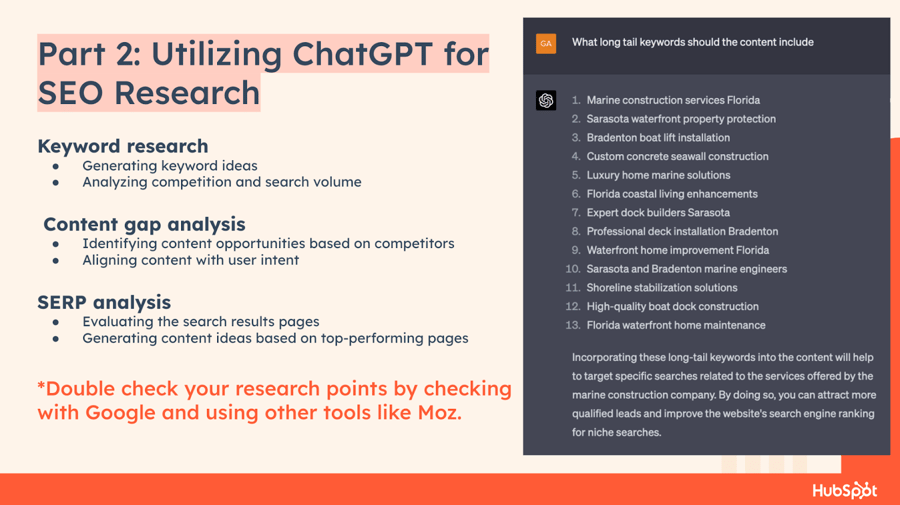
Double-check your research by using SEO tools like Moz or Ahrefs
ChatGPT can be a valuable tool for conducting SEO research, particularly when it comes to keyword research and competitor analysis. However, it's essential to understand the limitations of the technology and potential workarounds to maximize its effectiveness in your SEO strategy.
The role of ChatGPT in keyword research: ChatGPT can assist in generating keyword ideas based on the topics or themes you provide. It can help you identify long-tail keywords or explore various angles to approach your target audience. Additionally, ChatGPT can analyze existing content or blog articles to identify potential keywords they might rank for.
How to use ChatGPT for competitor analysis: While ChatGPT cannot directly visit competitor websites or analyze their traffic, it can still provide valuable insights when given specific information. For instance, you can paste entire blog articles from your competitors into ChatGPT and ask it to determine the primary keywords or the main essence of the article. This way, you can gain a better understanding of the content strategies employed by your competitors and identify potential areas to focus on in your own content creation.
Limitations of ChatGPT in SEO research and potential workarounds: ChatGPT has some limitations when it comes to SEO research. For example, it cannot access website data, analyze backlinks, or provide real-time traffic statistics. To overcome these limitations, consider using complementary tools, such as Google Analytics, Ahrefs, or Moz, to gather the necessary data. Once you have this information, you can input it into ChatGPT to generate insights or suggestions for improvement.
By understanding how to leverage ChatGPT for SEO research and incorporating additional tools and resources, you can develop a more comprehensive and effective SEO strategy that drives organic traffic to your website and improves your overall search engine rankings.
Related Blog: The New SEO Playbook: How AEO, GEO, and HubSpot Help You Show Up in Google AI and ChatGPT
ChatGPT for Blog Drafting and Content Creation

Feed the AI as much unique information as you can, the subject matter expertise comes from YOU.
ChatGPT has emerged as a powerful tool for streamlining the blog drafting process, helping content creators produce engaging and unique blog posts more efficiently. By understanding how to best utilize ChatGPT in your content creation workflow, you can enhance the overall quality of your blog while saving time and effort.
ChatGPT as a powerful tool for blog drafting: ChatGPT can generate ideas, outline articles, or even produce entire blog posts based on your prompts. It can help you overcome writer's block and quickly come up with creative and engaging content that resonates with your target audience. The AI's ability to process and understand vast amounts of information enables it to provide valuable insights and suggestions for your content.
Tips for using ChatGPT to create engaging and unique blog content: To get the most out of ChatGPT, start by providing clear and specific prompts, outlining the goals and objectives of your blog post. Experiment with different prompts and questions to generate diverse ideas and angles for your content. Additionally, consider using ChatGPT to conduct research, refine your blog's structure, or even create compelling headlines and subheadings.
The role of human involvement in refining AI-generated blog drafts: While ChatGPT can produce impressive content, it's crucial to recognize the importance of human involvement in the drafting process. Always review and edit the AI-generated drafts to ensure they align with your brand's voice and meet your specific content goals. Remember that the ideal formula for successful content creation is a combination of human input, AI assistance, and final human review. This approach ensures your content remains unique, engaging, and tailored to your audience's needs and preferences.
By incorporating ChatGPT into your blog drafting process and maintaining a balance between AI-generated content and human input, you can create high-quality, engaging, and unique blog posts that not only attract readers but also help establish your brand as an industry leader.
Limitations & SEO Implications of AI-Generated Content
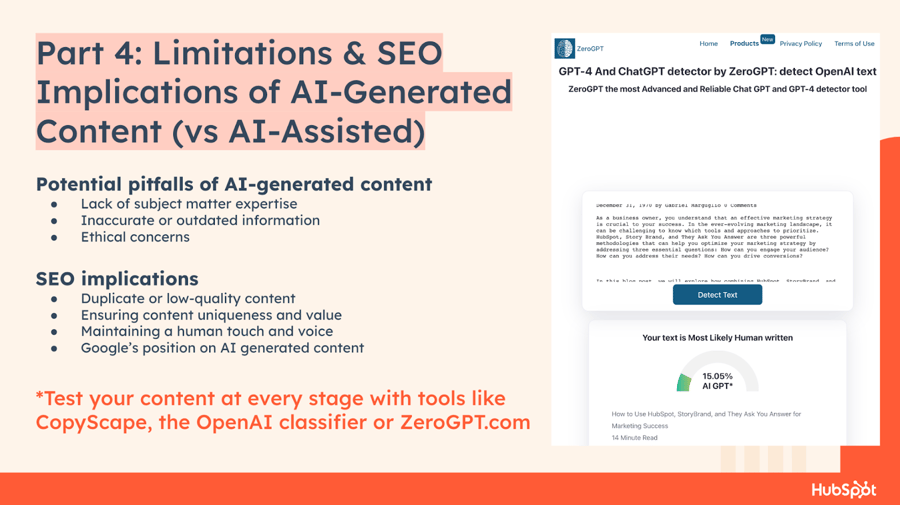
Test for repeated content and likelihood of being AI-generated with tools like CopyScape and ZeroGPT
As AI continues to play a more significant role in content creation, it's essential to understand how to maximize its impact while avoiding potential pitfalls. By ensuring the quality of AI-generated content through human intervention and focusing on unique, engaging content, you can stay ahead of the competition and make the most of AI-assisted content creation.
The importance of unique and engaging content in the age of AI: As AI-generated content becomes more widespread, standing out with unique and engaging content is more important than ever. Instead of focusing solely on producing content quickly, invest time and effort in creating high-quality content that captures your audience's attention and encourages them to return. By prioritizing quality over quantity, you can build brand affinity, increase engagement, and ultimately drive better results for your business.
Avoiding AI-generated spam and focusing on AI-assisted content: With the growing use of AI in content creation, there's a risk of producing generic or spammy content that lacks value for your audience. To avoid this, shift your focus from AI-generated content to AI-assisted content, where AI tools like ChatGPT serve as a support mechanism rather than the sole content creator. By incorporating human expertise and creativity, you can ensure your content remains unique, engaging, and valuable to your audience.
By carefully considering the role of AI in your content creation process and implementing strategies to maximize impact and avoid potential pitfalls, you can successfully leverage AI-assisted content creation to elevate your brand, engage your audience, and achieve your business goals.
How do you ensure ChatGPT content stays unique?
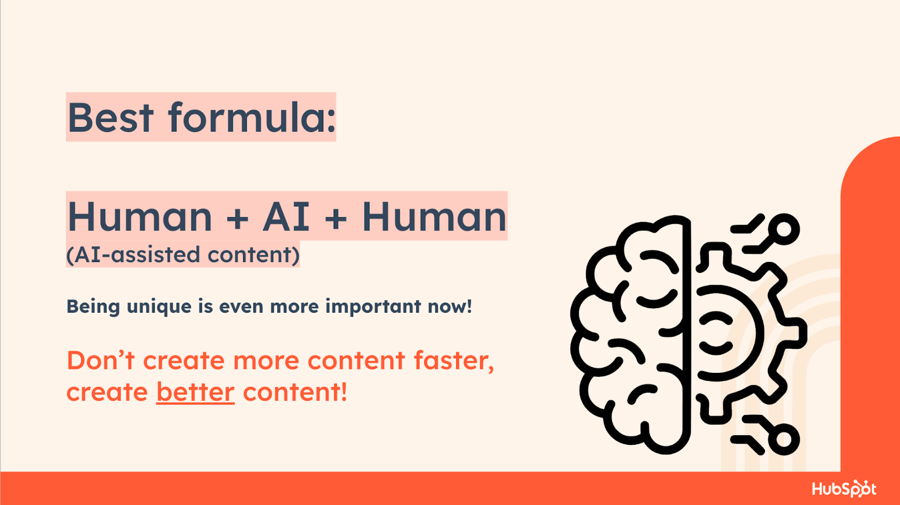
Don’t create more content faster, create BETTER content!
As we've explored throughout this blog, ChatGPT holds tremendous potential for website content creation, SEO research, and blog drafting. To maximize its impact, it's important to remember the key points we've discussed: the value of AI-assisted content over AI-generated content, the importance of human involvement in refining the AI-generated output, and the need for a strategic approach when using ChatGPT for various tasks.
As AI technology continues to advance, we encourage you to explore other AI tools that can help improve your content generation and optimization efforts, such as ChatSpot, which integrates with HubSpot CRM to provide a more streamlined user experience. By staying informed and adaptive, you can harness the power of AI to enhance your marketing strategies, create better content, and drive success for your business.
![How to Use ChatGPT for Website Content, SEO Research, and Blog Drafting [HubSpot Workshop]](https://blog.nextinymarketing.com/hubfs/chatgptthumb.png)

.png)

-1-1.png)
